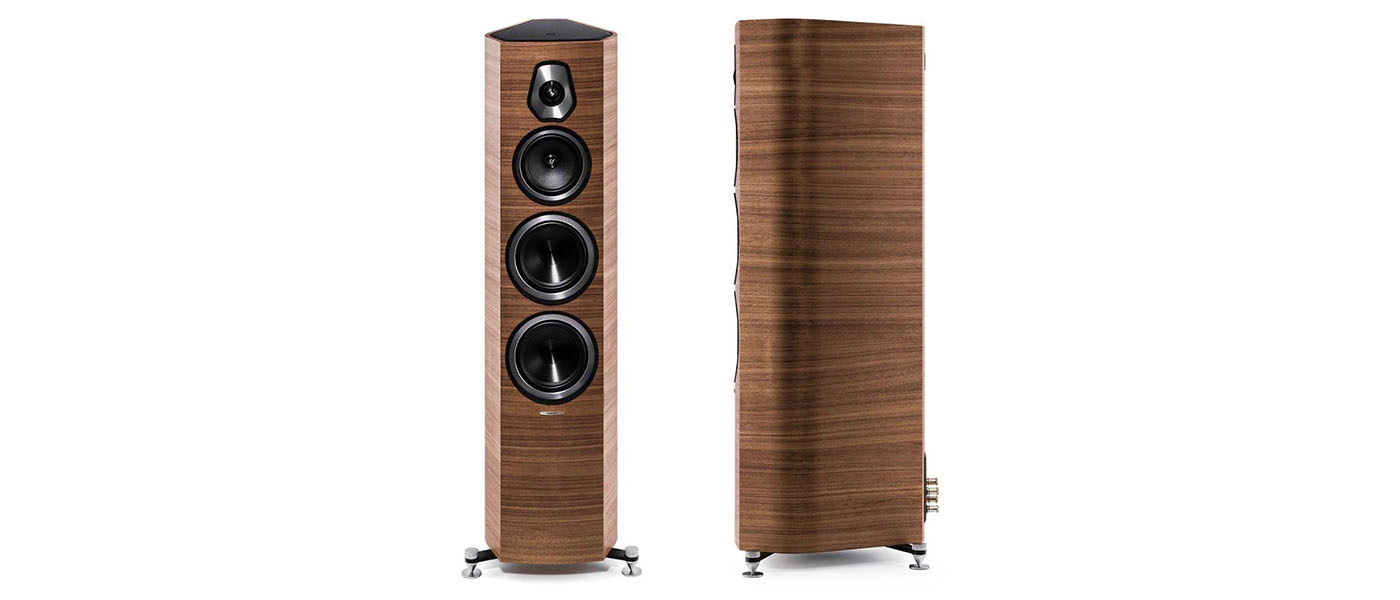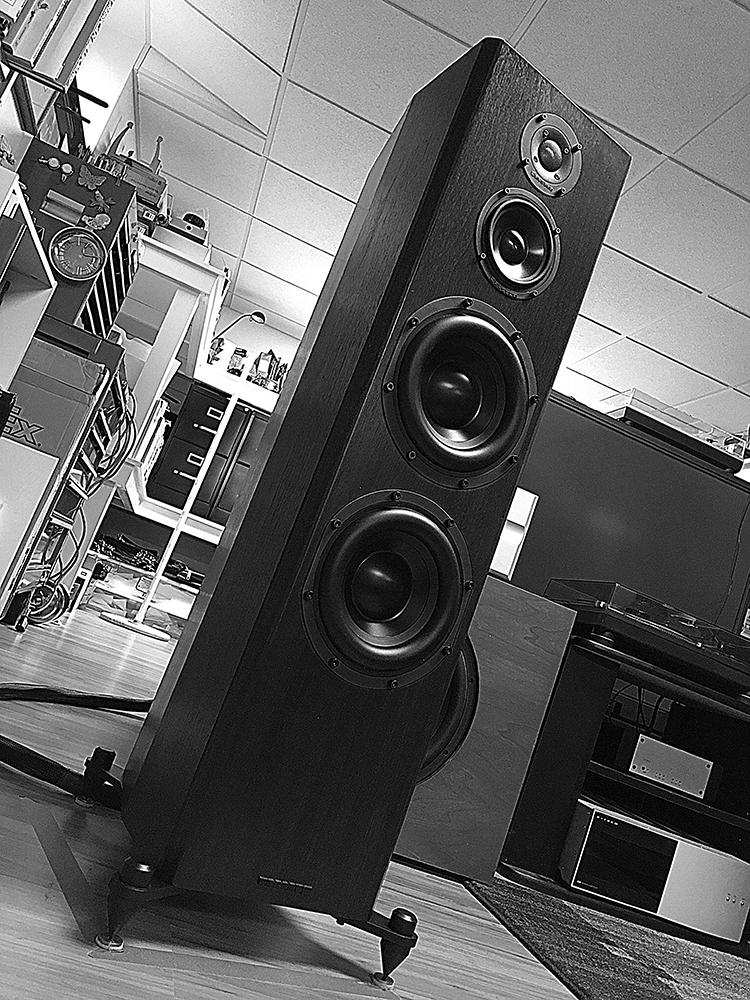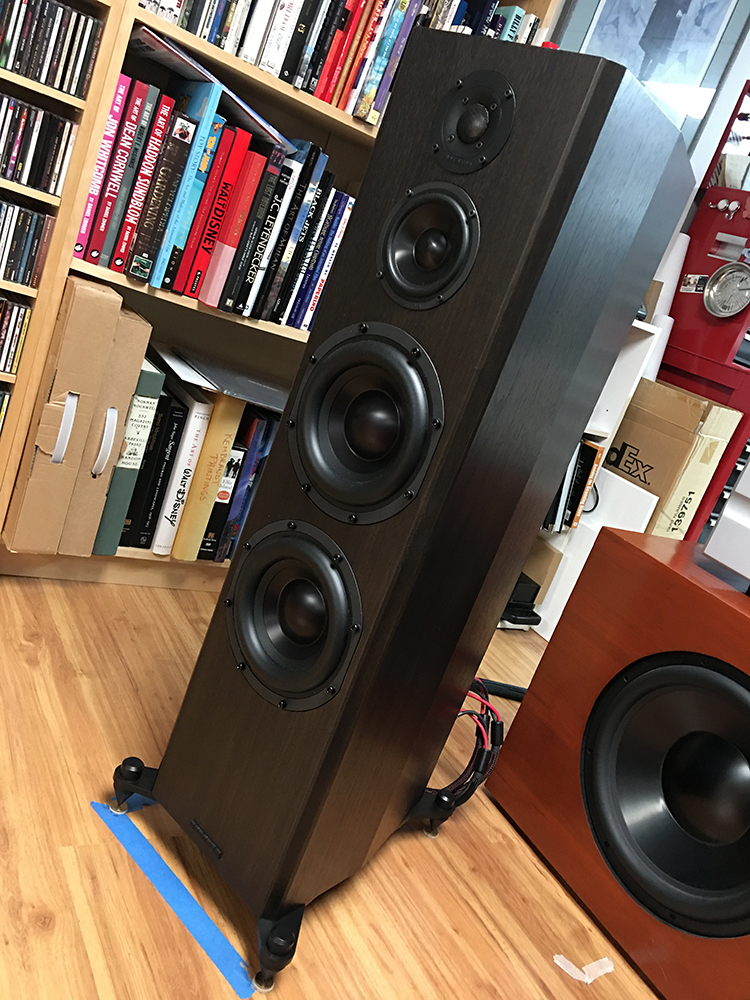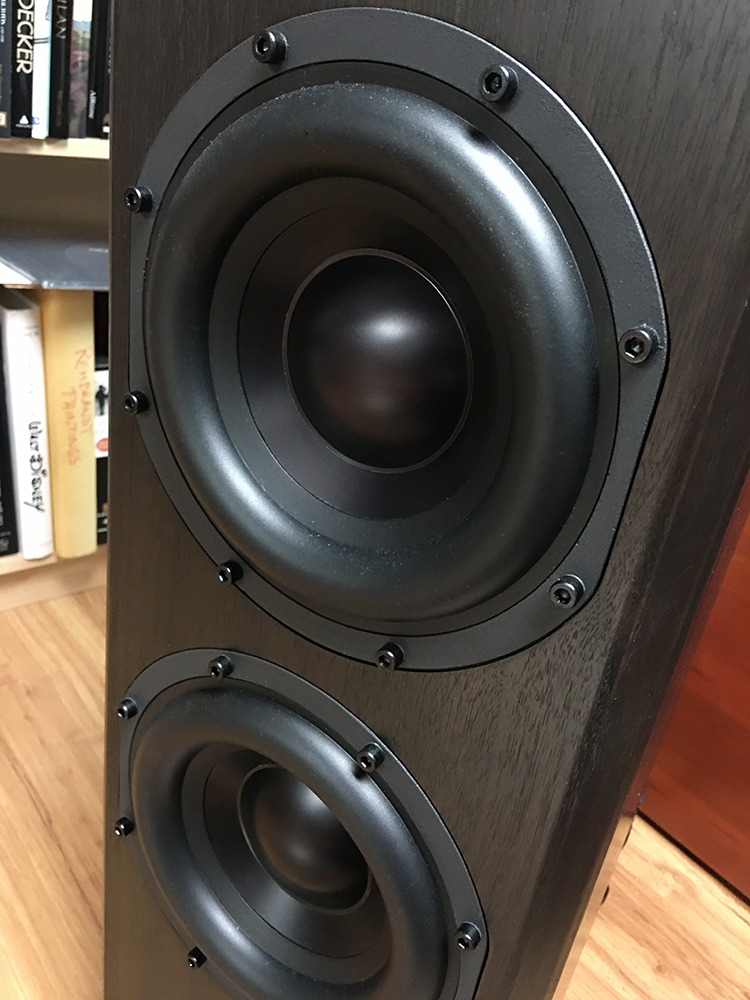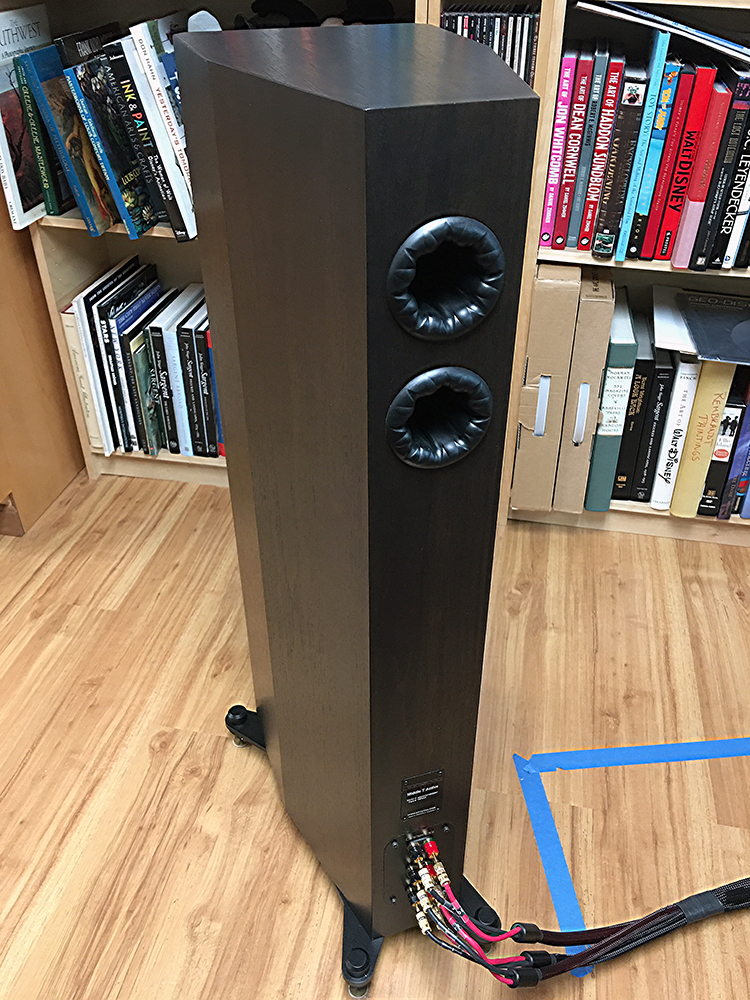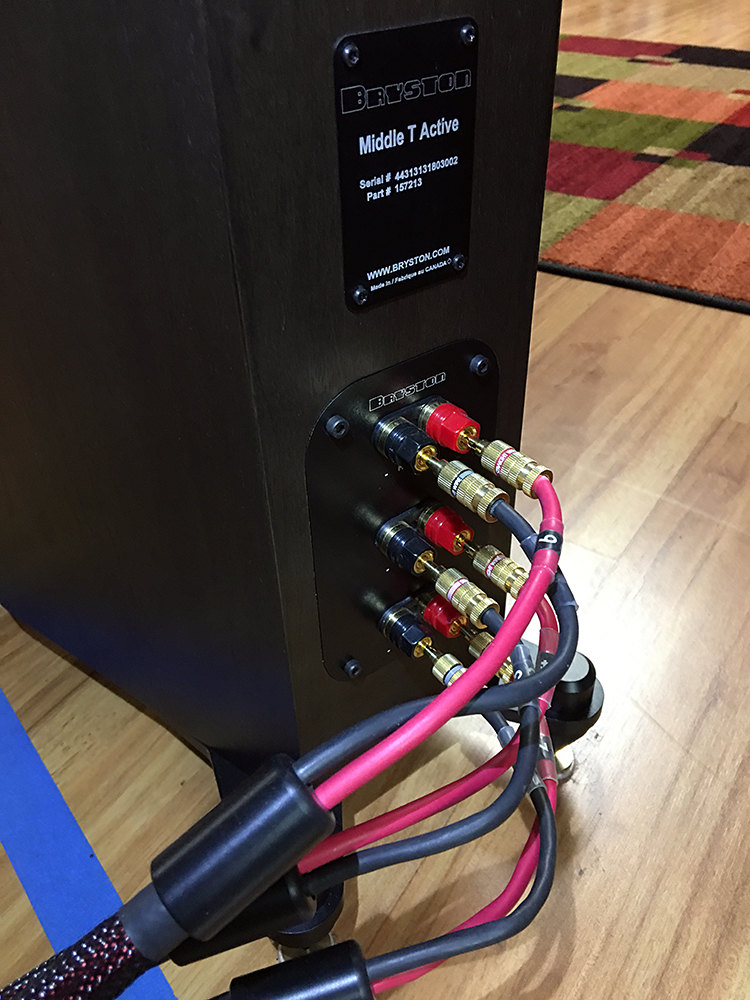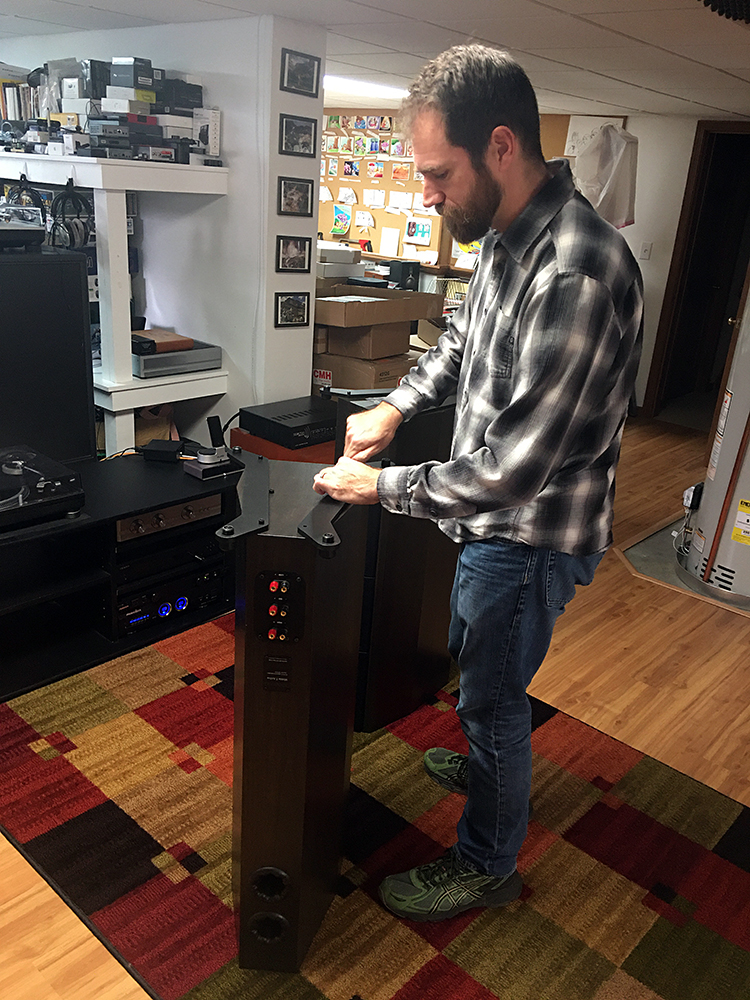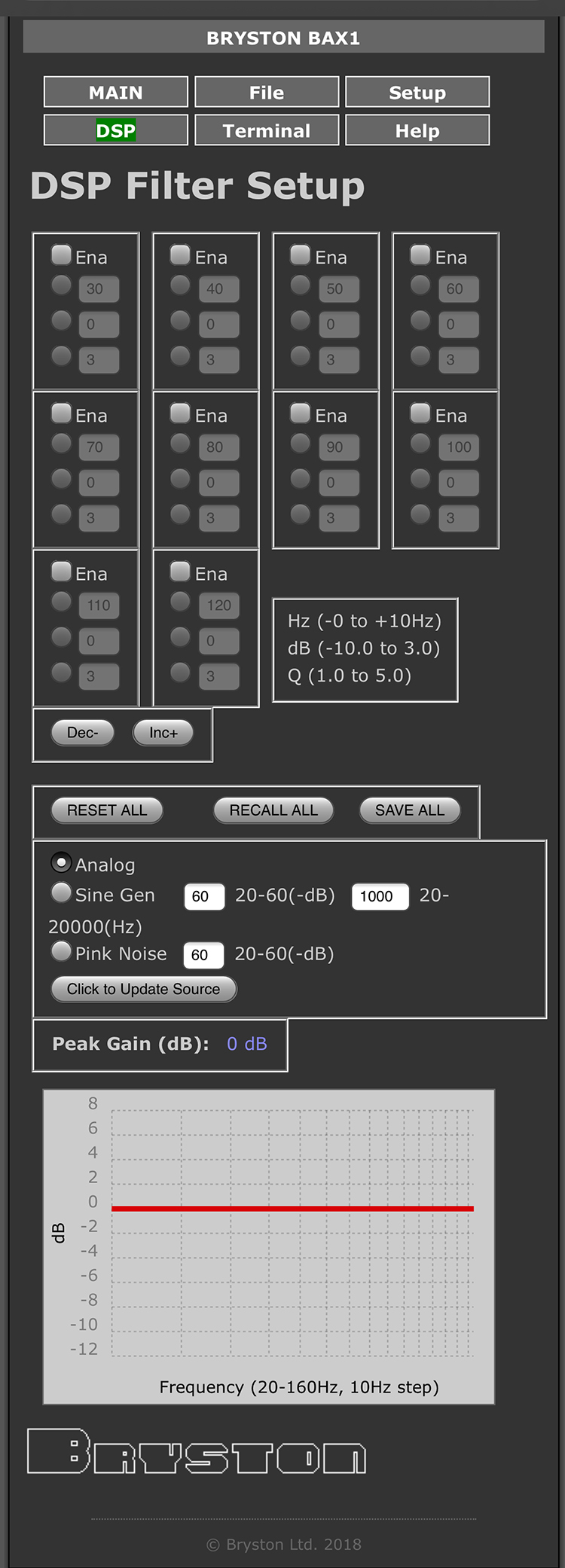
At first glance, the Bryston Middle T Active loudspeakers appear like an “old-school” implementation of an active speaker approach, with an external 3-way electronic crossover and external amplification resources. However, the fine folks from Peterborough have added a few “new-school” twists to the recipe, in the form of DSP, as all signals coming into the crossover are converted, filtered, and processed at 24-bit/96 kHz before being converted back to analog and sent off to the amps.
Bryston Middle T Active Speaker Review
- Excellent imaging quality.
- Clean, dynamic sound both on and off-axis.
- The two Bryston 21B cubed amplifiers seemed to have an unending well of power on tap.
- Excellent bass response in my room.
- A very complete, but very expensive solution.
- Bryston quality.
In my misbegotten youth, soon after I had been bitten hard by the audiophile bug, the third real speaker system I had owned after my Image Concept 200 towers and a pair of Newform Research R630 towers was a 2.2 channel active speaker solution. Designed by a local Toronto maker called Ascent Acoustics (no longer around) it was a bizarre genetic bouillabaisse of a system. It was comprised of two small sealed monitors on integrated stands that each used a large copper dome tweeter from Celestion and a KEF B110 midrange driver.
The two sealed subwoofers were each about 4 to 5 cubic foot enclosures housing a single JBL Professional 2235H 15-inch driver. This weird assemblage of drive units was tied together by a custom external 3-way electronic crossover full of discreet components and level adjustment pots on the back for each channel. I remember using an old ADCOM and a pair of Carver amplifiers to power the whole shebang. This system was finicky as hell to set up and it took a lot of time to dial in, but once done it really sounded like something special. The speaker designer, whose name I have long since forgotten, did his due diligence in designing that system as the electronic crossover did it’s level best in taking three pairs of drivers that probably had no business being together and getting them to work harmoniously. It’s the speaker system that I’ve owned for the longest time, parting with it only about 5 years ago. Having it taught me several things about speakers in general and about what would (or wouldn’t) happen when I would swap different components. For the longest time, it sounded better to me than anything else that I could reasonably afford and a few things that I couldn’t, and a lot of that was due to the active nature of the system. The electronic crossover had been designed to actively deal with the strengths and weaknesses of each of the drivers in their given enclosures with the amplification coming at the end of the chain, thus reducing any of the inherent losses found in a passive system. I also had a certain degree of flexibility with the amplification I could use since each of the channels had independent level adjustments. The whole thing wasn’t particularly pretty looking. It was a system that would surely make Dr.Frankenstein proud. But it clearly spelled out to me, early on, what the benefits of an active Hi-Fi speaker system could be.
So it strangely closes the circle, some 28 years later, that Bryston presents me with the opportunity to review their Middle T Active speaker system. It’s like the strangest form of deja-vu; drivers in a box, an external 3-way electronic crossover, plenty of external amplification. Bryston even said that my 20-year-old BP-25 preamp was still good enough to use with the new Middle T. I used that same preamp with the old system for many years. The Middle T Active system is exponentially more advanced in design and technical ability than what my hodge-podge system of old was even capable of. It’s sort of like comparing a lightsaber to a bowie knife. But at the end of the day, the concept is still the same and the benefits are still undeniable. The question is, how good is the execution?
Bryston Middle T Active Speaker
Description:
3-way Bass Reflex Active Floor-standing Loudspeaker with dual rear-firing ports
High-Frequency Driver:
Single 1″ Titanium Dome
Mid-Frequency Driver:
Single 5.25″ Aluminum cone driver
Low-Frequency Driver:
Dual 8″ Aluminum cone drivers
Frequency Response:
33Hz to 22Khz (+/- 3dB) (Manufacturer)
Maximum SPL:
112 dB SPL @ 1 meter
Nominal Impedance:
4 Ohms
Sensitivity:
88 dB SPL @ 1 meter @ 1 watt (anechoic)
Cabinet finishes:
Black Ash, Boston Cherry, Walnut, or Espresso Walnut. Custom Veneer at extra cost.
Dimensions (H x W x D):
39.5” x 10.5” x 16.5”
Net weight:
81 Ibs (37 kg) (each)
MSRP:
$8,685.00 (pair) (Speakers alone)
Bryston BAX-1 Active DSP Crossover
Description:
3-Way Electronic Crossover with DSP
A/D Chipset:
Two AKM AK 5572 Analog to Digital converters
D/A Chipset:
Six AKM AK 4490 Digital to Analog converters
Internal Sampling Rate:
24-Bit / 96 kHz
Input:
Two Balanced XLR inputs
Outputs:
Six Balanced XLR Outputs (3 pairs- Highs, Mids, Low)
Dimensions (H x W x D):
2.75” x 17.0” or 19.0“ x 11.11”
Net weight:
10.3 lbs (4.7 kg)
Finish Options:
Silver or Black
MSRP:
$3,495.00
Bryston 21B³ Power Amplifier
Description:
3-Channel Class AB Power Amplifier
Power Output:
CH 1: 600W @ 8Ω / 900W @ 4Ω,
CH 2 & 3: 300W @ 8Ω / 500W @ 4Ω
Frequency Response:
<1Hz – 100kHz (-3dB)
THD+N (20Hz-20kHz @ Rated Power, 8Ω):
<0.005%
Noise:
RCA: <-115dB
XLR: <-116dB
Input Impedance:
Unbalanced 7.5kΩ, Balanced 5kΩ / leg
Gain:
Switchable (23dB or 29dB)
Dimensions (H x W x D):
8.1” x 17” or 19” x 16.8” or 18.4” (with front handles)
Net Weight:
91 lbs / 41 kg
Finish Options:
Silver or Black
MSRP:
$12,195.00 each
Company:
Company Directory:
SECRETS Tags:
bryston, active, dsp, crossover, active-speaker, Speaker Review 2020
As it is well known by now when Bryston decided to take on the task of creating a line of passive speakers, they partnered with fellow Canadian firm Axiom Audio to help with that endeavor. And why not? Axiom has a pool of speaker engineering talent that can trace its roots back to Canada’s NRC (National Research Council) and the research work begun by Floyd Toole and others. They also have their own anechoic chamber on-site which is considerably handy. And while Bryston speakers visually resemble the shape of some of Axiom’s speaker models, the drivers, crossovers, and enclosure construction details are designed to Bryston’s specifications. For the active speaker line, Bryston followed a template from their own history book when they partnered with another Canadian company, Waveform, and provided a specialized external electronic crossover and amplification for the fully active Waveform Mach 17 loudspeakers (anyone remembers those?).
Beginning with the speakers themselves, at 39.5 inches high the Middle T is a moderately sized floor-standing tower. They have a wider front baffle with angled sidewalls that join a narrower rear wall. Tipping the scales at 81 pounds each, the cabinet construction seems resoundingly solid with a 1.5-inch thick front baffle, 0.75-inch side, and rear walls, and reportedly extensive internal bracing. The driver complement consists of a 1-inch titanium dome tweeter set in a modest waveguide, a 5-inch aluminum midrange driver and two 8-inch aluminum woofers with beefy rubber surrounds. The rear of the Middle-T has two scalloped (I believe Axiom calls them Vortex) tuned ports towards the top of the speaker while at the bottom there are three pairs of speaker binding posts, each pair marked either “High”, “Mid” or “Low”. Disappointingly, the terminations are not physically different for each of the three bands. Accidentally connecting the woofer amp to the tweeter or midrange will result in a disaster as would connecting the midrange to the tweeter. Special cables that were terminated to fit only the correct driver connection would have been useful.
The entire speaker sits on a pair of substantial aluminum outrigger legs with massive spikes on each of the four ends. I slipped some metal disks with felt feet under each spike to protect my studio floor. The speakers come with unusual 3-piece black fabric grilles that fasten magnetically to the front face of each speaker. I kept them off as is my usual want. My Middle T review sample was nicely finished in the Espresso Walnut veneer. The overall look is very practical and understated. Essentially, they look very Canadian!
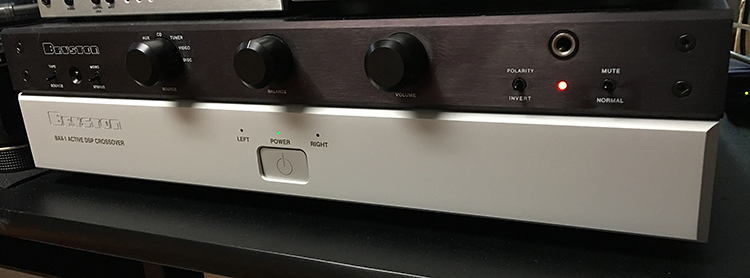
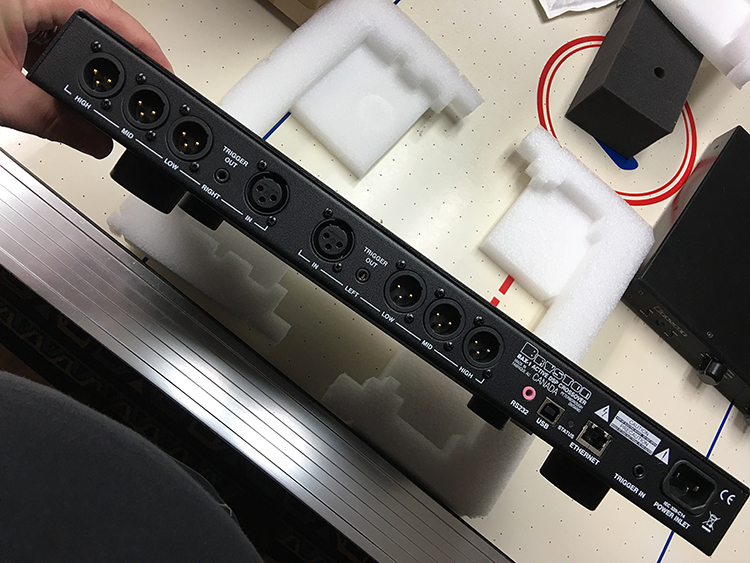
The Active Middle T comes with a Bryston external electronic crossover, the BAX-1. While Bryston has had adjustable analog electronic crossovers in their catalog for years that were usable with any speakers or subwoofers, the BAX-1 is more of a digital unit custom developed for Bryston’s homegrown active line. It accepts a Left and Right balanced input from your preamp of choice (Bryston hopes you will use one of their fine examples) and the incoming signal is immediately converted to a 24-bit / 96 kHz digital bitstream via two AKM AK 5572 ADC chips, one per channel. All signal processing, crossover filtering, and other DSP voodoo are performed in the digital domain and the results are converted to analog by six AKM AK 4490 DAC chips, each run in mono mode. Bryston says that the BAX-1 uses IIR (Infinite Impulse Response) filters in its crossover and EQ processing. There are six balanced XLR outputs, three per channel, that are divided into High, Mid, and Low to which one connects the amplifiers. The crossover has a web-based interface that an owner or installer can use to download and apply the appropriate Bryston Active speaker configuration and set up to 10 available bands of parametric-EQ. You are only able to apply that EQ to the bass region, up to 150 Hz as that tends to be where the biggest room/speaker interaction issues crop up. The BAX-1 connects to your home network via an Ethernet jack on the back of the unit.
Unlike the analog active crossover network in the ELAC Navis loudspeakers or Carlo’s old active system that he referenced, Bryston chose to go the DSP route in the BAX-1 crossover. There are several intelligent reasons for this:
-
- 1. One can design a much more complex filter in DSP compared to a few inductors, resistors, and capacitors in a passive or even an analog active system.
- 2. DSP allows filters that cannot be synthesized in the passive domain. Finite impulse response filters are possible. Computation that is not causal is possible – one can look forward and back at a digital signal to determine a sample point to be sent to a driver. Phase correction is possible with non-causal filters although it is unclear if that does anything positive. Bryston is not correcting the phase here.
- 3. Drivers present complex impedances. This interacts with a passive crossover. In an active system, with the amplifier directly connected to the drivers, the speaker sees a flat response at the terminals. The acoustic performance of the driver is isolated. The non-ideal response of the driver, now isolated, can be corrected with the DSP filter. Custom compensation for a specific driver shipped with the speakers is possible although this presents issues if a replacement is needed as the DSP code must be updated.
- 4. In passive speakers, crossover components see very large voltage swings and high current flows in them. This results in non-linearities that can be measured easily and are high enough to be audible, especially in iron core inductors and electrolytic capacitors. Moving to air-core inductors and film capacitors are prohibitively expensive at lower crossover frequencies. Passive speakers also have very complex impedance plots and can be difficult to drive. This is due to the passive crossover network and the overlapping impedances of the drivers. Dealing with an individual driver gives us a much easier impedance to drive. What comes out of the amplifier terminal in an active design winds up at the voice coil exactly.
- 5. Passive components have tolerances. Capacitors and inductors are within 5% or even 10% of the specified value. The speaker’s impedance also varies from sample to sample. Combine all the tolerance changes of each component and the desired frequency response of the speaker has changed by a significant amount. This results in pair matching errors that effect stereo imaging. DSP has no such tolerance errors. Every box produces the same response.
- 6. Bryston’s approach has significant advantages for those who want to keep a speaker for a long time. The amplifiers inside an active speaker have little space and occasional ventilation problems. Parts availability may be 5 years or less if the company still exists. The DSP section of an all in one box speaker may also have parts that cannot be replaced and sometimes the company puts a limit on the time it will repair the electronics.
- 7. To ensure 10 years or more of uptime the DSP filter code should be portable to a newer external DSP box if the old one becomes obsolete or is not reparable.
- 8. Bryston can continue development of the DSP code for the speaker. If they make an improvement, all they have to do is send you the code to download.

Above is a curve pair of the response of the passive Middle T and active Middle T provided by Bryston. Each curve shows the listening window response and power response. Note that they are not flattening the listening window with DSP completely. You would see the active curve get as flat as ice if they did that.
What Bryston does is use the fact that they are applying DSP correction to each driver, not to the whole speaker.
That gives an extra degree of freedom when applying DSP filters to each driver span around the crossover points. For the woofer – midrange the crossover is 500Hz and they overlap between 300Hz – 1.8kHz. The midrange – tweeter crossover at 2kHz and the overlap runs from about 2.2kHz to 3.5kHz. In these regions, Bryston can adjust the sound power and the listening window in different directions. This is something other speaker designers may take advantage of but they talk of it in very technical terms. Bryston has come up with a brilliant explanation and it never occurred to me before that it could be this easy to explain.
The graph pair above shows the Bryston concept in practice. Both the early reflection curve and the power spectrum have been improved. Outside the crossover area, the changes track each other. In the crossover, the correction becomes almost independent.
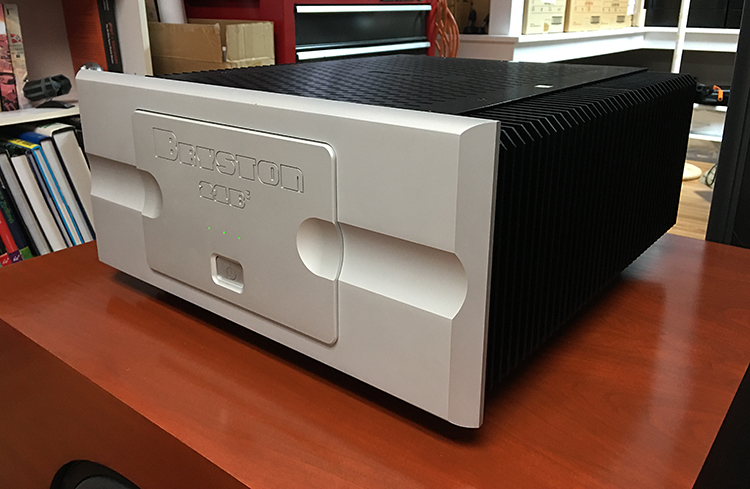

The Bryston 21B³ power amplifier is the most potent amp that I have ever had in my house and the Active Middle T speakers require a pair of them to start the show. Sporting 3 channels each (2 x 300 watts and 1 x 600 watts) if the speakers were to underperform in any way it certainly wouldn’t be for lack of juice! Bryston knows a thing or three about making amplifiers and these current “Cubed Series” feature several refinements over previous generations, one of which is a new input buffer design called the Salome Circuit. In an email exchange, Chris Russell, CEO of Bryston, explained the circuit’s benefits: “There are three benefits from the Salome patented input circuit: The first and second are that the THD and IMD are below 0.001%, (‘triple-zero THD’), from 20 to 20K, and with better noise specs, by 3-5dB. The third benefit is at least as important, and that is its rejection of power-supply, (PSRR), and common-mode incoming noise, (CMRR), are extremely high, more than 20dB greater than before. That means the incoming signal is stripped of any interference that could come in on the cabling. That almost always results in a cleaner signal overall.”
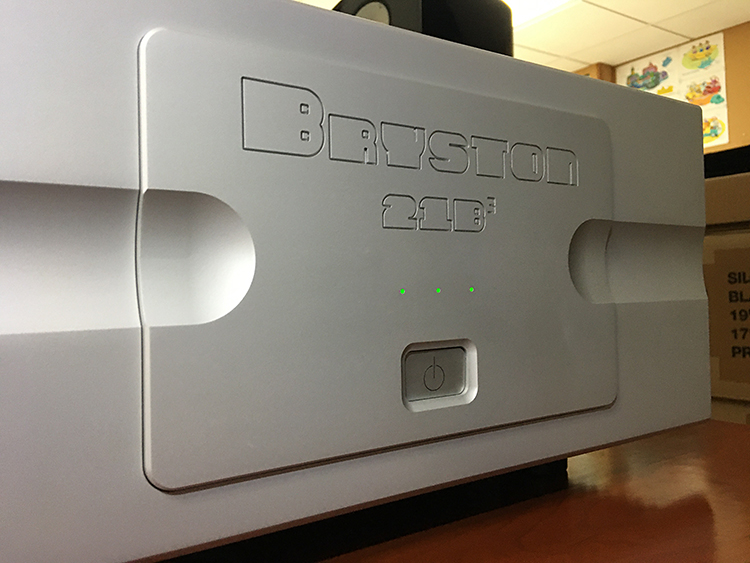
From an aesthetic perspective, the Bryston 21B³ certainly look the business. With a design style that I can only describe as an “elegant sort of brutalism,” these amps exude a level of confidence and certainty in their claimed abilities that any owner should appreciate. And after examining the build quality of these self-contained power stations, I’m left with the feeling that they will likely be powering speakers somewhere, long after my time on this planet is over. Looking a little closer, the machined thick aluminum faceplate sports a simple power button with 3 channel status LEDs just above it, while the back has 3 sets of XLR and RCA inputs along with 3 sets of high-quality multi-way speaker binding posts. There is also a gain selector switch where one can choose either 23 or 29 dB of gain, along with an XLR/RCA input selector switch and a 12V trigger switch below those. Both sides of the amps are taken up with thick black anodized aluminum heat sink fins. You can specify either a 17-inch or 19-inch front faceplate for this amplifier. The 19-inch faceplate comes with beefy matching aluminum front handles to complete the look and thoroughly intimidate any lesser amplifiers that may be in the general vicinity. It should be noted that the Middle T Actives will work just fine with several other quality multichannel amplifiers if you already possess them or Bryston power is initially outside your budget.
Also worth mentioning is that Bryston’s warranty period on the speakers and amplifiers is 20 years, while the BAX-1 is warranted for 5 years. According to Bryston, digital electronics are limited to only a 5-year warranty due to the rapid advancements that continue in digital chips. Guaranteeing a subsequent replacement part supply for 20 years or more of said chips is a tenuous proposition.
Soon after the Middle T Active speakers and the associated gear arrived at my home, I was visited by Bryston’s Vice President of US sales, the jovial Gary Dayton, and he helped me get things connected and set up. Once Gary got a look and feel for my listening environment, we positioned the Bryston Middle T Active Speakers in my studio area just over 9-feet apart and toed-in at about a 15-degree angle. My seating location was also just under 10-feet away from either speaker. Once we downloaded the appropriate active speaker configuration files into the BAX-1 crossover, we fired everything up, and both did a bunch of listening and tweaking to the speaker’s placement until we were satisfied with the results.
An OPPO BDP-105D Universal Player served as a main audio source along with an ELAC Discovery Music server using ROON to manage my music files. My 20-plus-year-old Bryston BP-25 preamplifier was pressed into service as the main control center and it seemed to fit into the active audio puzzle chain perfectly, just ahead of the crossover. For a vinyl source, I used my Technics SL1200 Mk 6 modified by KAB Electroacoustic, along with an Audio Technica OC9ML/II Moving Coil phono cartridge. This was hooked up to the Pass Labs XP-25 Phono preamp. The speaker cables were custom made runs provided by Bryston for use with an active system.
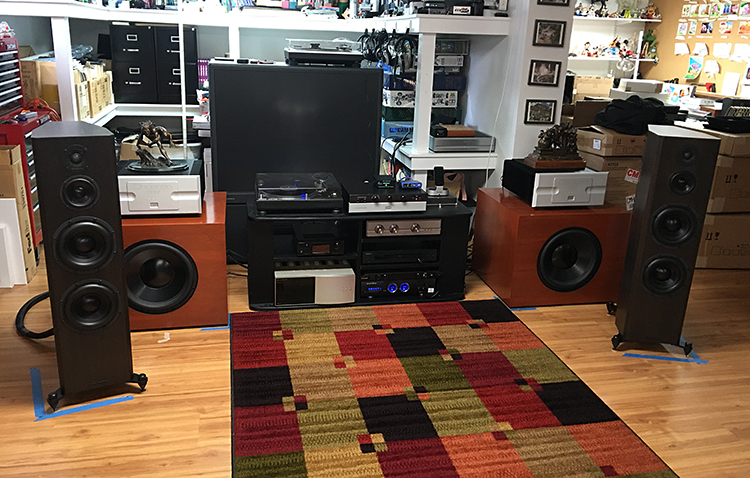
When I had heard the larger Model T Active at last year’s RMAF, I was impressed by the sheer dynamics and resolving power of the system as a whole. For my review, the smaller Middle T seemed the right way to go for my basement studio as my ceilings top out at 7.5 feet high. In my listening space, the Middle T Actives shared similar characteristics of their bigger brothers to my ears. With the speakers toed in to converge just beyond my listening position, the overall sound quality was scrupulously detailed and transparent, with a sheer lung capacity and sense of dynamics that I would normally associate with powerful horn speakers. Imaging was impressively deep and wide which made it easy to place individual instruments in a performance and with the two big 3 channel amplifiers running the system, there seemed to be no bottom to the power well from which I was drawing from. I could turn the volume up to utterly ridiculous levels and not feel like I was taxing this system in the slightest. Bass response was impactful and impressively solid down to what felt like the upper twenties to low thirties. Practically speaking, no subwoofer needed to apply. With both male and female vocal performances, I definitely got a sharp and defined picture of the singer in my listening space. With close mic’d singers, where I can hear their breaths and other subtle details between the lyrics, the sense of presence was almost palpable. There was the odd song that made me feel that the upper bass was perhaps subtly over-pronounced, but I think those were more the fault of the individual recordings than the speakers as it wasn’t a common experience.
Seeing as they have a similar driver complement when I compared the Middle T Actives to the Revel F228 Be that I had previously reviewed, I came away with a few different observations. When using no room correction and pressing the 600-watt channel on each of the Bryston amps to power the Revels, I felt that the Brystons had more dynamics that the F228Be, particularly at higher volumes. The Bryston Active speakers were more exciting to listen to while the Revels were a little calmer by comparison. That’s not to say that the Revels sounded soft by any stretch of the imagination, far from it. The sound of the Brystons simply grabbed my attention more and I felt that they resolved that last little bit of detail better due to their active design. I will say however that the aesthetics of the Revels appealed more to me than the more straightforward looking Brystons. And it should also be noted that pushing 600 watts of 21B³ power through each of the Revels lit up the bottom end of those speakers like nobody’s business! If nothing else this little experiment made me wonder how much farther Revel could push their big Performa Be speakers if they went active. Food for thought!
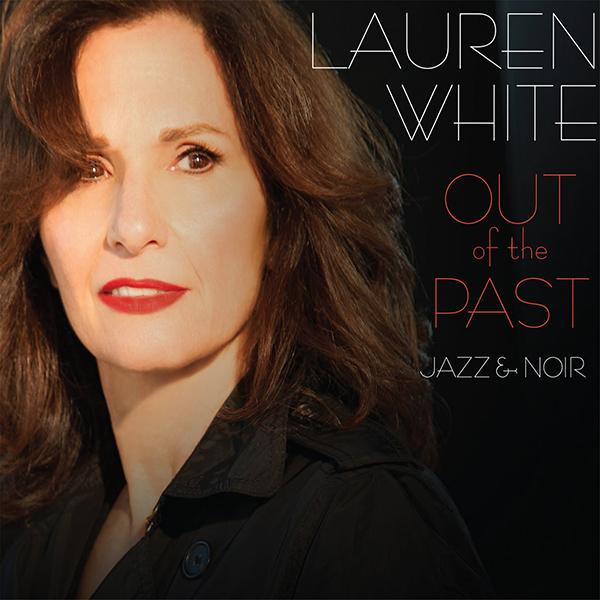
Lauren White, Out of the past: Jazz & Noir, Café Pacific, 16/44 via Qobuz, 2016
I stumbled across this album on Qobuz, and very much as the title implies, it’s the kind of jazz music one would associate with a hard-boiled detective mystery or some other similar scenario. It’s a nicely recorded set of songs and Ms. White’s vocals are clearly, if a little forwardly, presented in the track “When All the Lights in the Sign Worked”.
Again, the Middle T Actives set up a wide canvas for the instruments and vocals to be painted on to. The muted trumpet sounds crisp and ragged (in a good way) but doesn’t grate on the ears. Bass plucks are thick and full sounding but without slop or overhang and the backing piano plays cleanly with a superb ring and decay to the notes. The good sounds continue on the medley “Laura/The Night We Called it a Day” with a smooth vocal rendition by Ms. White but her voice still was reproduced with such precision and clarity by the Bryston speakers. She sounded convincingly in the room. Even well off-axis, her voice sounded eerily real and dimensional. “Amando Mio” starts with a crisp and detailed Spanish guitar opening where I could pick out loads of individual details in the strings. Vocals continued to sound top-notch with a nice ensemble of backing strings and piano. The riding cymbal also sounded impeccably good, not brash, or overly sizzled at all. While possibly a little too kitschy for some people’s taste, this is a delightfully clean sounding array of tunes and the Middle T Actives made them sound extra special to me.
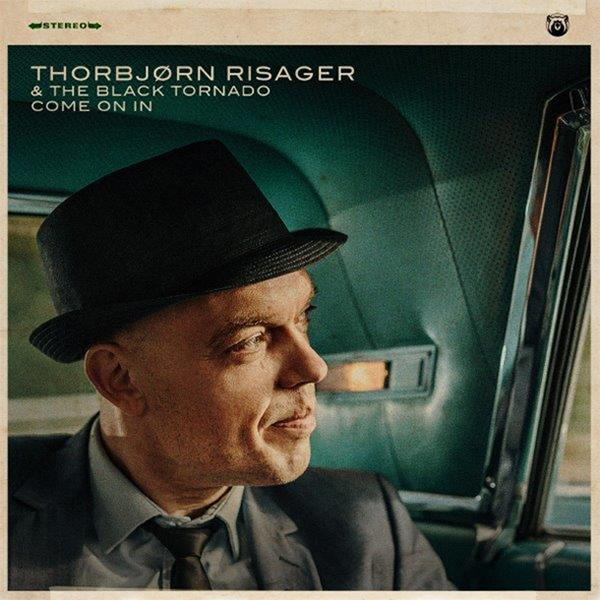
Thorbjorn Risager & The Black Tornado, Come On In, Ruf Records, 24/44 via Qobuz, 2020
I first discovered this Danish blues singer and his band courtesy of a music sampler recorded by DALI Music. A quick resulting search on Qobuz brought up a few of his previous albums and this brand new one on the German Ruf Records label. “Come On In” has the Bryston’s grabbing the title track’s deep burbling bassline and punchy kick drum opening and spreading the presentation wide in front of me.
Risager’s gravelly baritone voice is nicely projected between the speakers with all the rich vocal character oozing from the lyrics. The ghostly sounding electric guitar that backs the track sounds like it emanated from well beyond the speaker boundaries. The overall presentation from the Middle T Active was big, full, and detailed, with a nice bottom end punch that made the song really groove. “Two Lovers” is a slow-burning blues tune and Risager’s voice again just sounds so detailed and full of character with a guttural weight to it that the Bryston’s handle adroitly, without imparting any muddiness to it. A steel resonator guitar is strumming in accompaniment and that unmistakable hollow metallic ring of the guitar body comes through loud and clear. Nice string detail too. “On and On” is another slow and standout track. Great late-night mood music for when it’s just you and a pair of fine speakers.
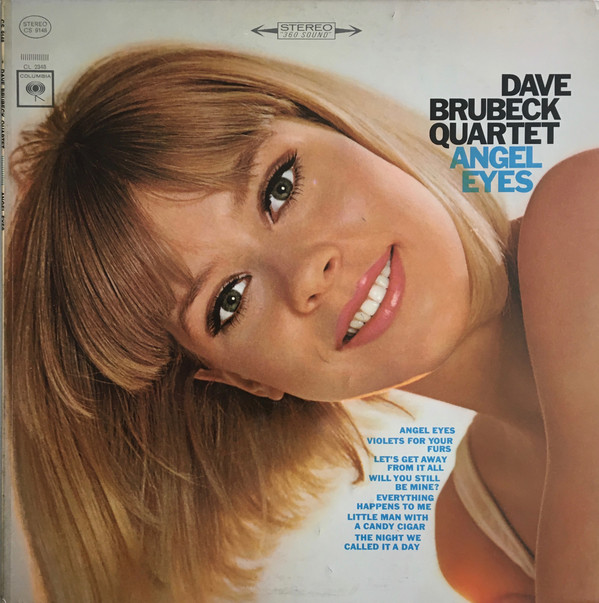
Dave Brubeck Quartet/Angel Eyes, Columbia Records, LP. CS-9148, 1965
A nice, lively set with Dave Brubeck on piano, Paul Desmond on alto sax, Eugene Wright on bass and Joe Morello on drums. The Middle T Active does a nice job handling vinyl, in that they aren’t particularly vicious to the medium, overtly highlighting the inherently lower dynamic range over a digital source. On a nice recording like this one the speakers really push the good aspects across, like Paul Desmond’s saxophone sounding precisely placed and lush on “Everything Happens to Me.”
All the while the prodigious low-end ability of the Middle T Active gives a solid and pitch-perfect foundation to Wright’s standup bass work. “Lets Get Away From it All” has nice crisp cymbal work that sounds properly metallic and Desmond’s sax playing, again, is the attention-getter with just a really lovely tone. Brubeck’s piano does sound a little flat in this recording in comparison to the rest of his crew which all seem to have much more dimension and spread than his piano does. Okay, so the Brystons cannot hide all the flaws in a recording after all. They just won’t pull a “Mean Girls” routine on the flaws that they do uncover.
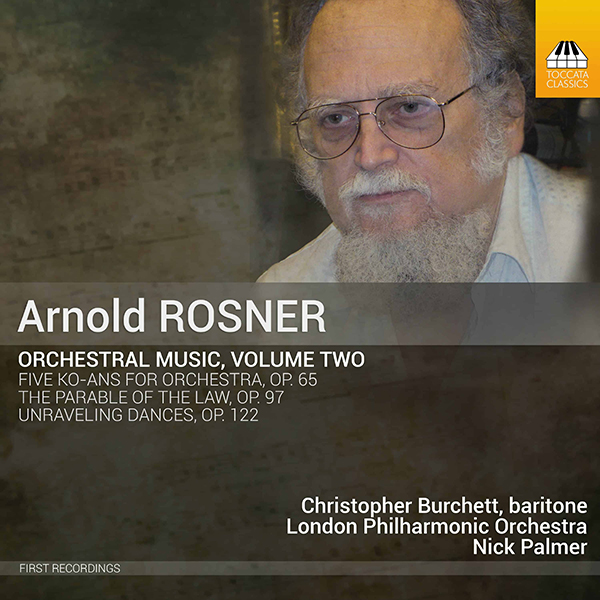
Arnold Rosner, Orchestral Music Volume 2, Toccata Classics, 24/96 via Qobuz, 2018
A thank you to David Rich for introducing me to the work of Arnold Rosner. This is very “cinematic” music in its scope with wide swings in volume and intensity. “The Five Ko-ans for Orchestra, Op. 65” really put the Middle T Actives through their paces and I think gave the 21B³ power amplifiers a good exercising. Beginning with “No.1 Music of Changes” the Middle T Actives spread the orchestra well past the speaker boundaries and provided an excellent sense of depth to the soundstage.
I could easily locate the various instrument sections of the orchestra; each being clearly delineated in space. The quick swings, for example, from quiet single clarinet and subtle accompanying strings to full bore orchestra with pounding tympani drums did not seem to ruffle either speakers or the amplifiers but it certainly shook the room at volume. I did not get the sense that any compression of sounds or detail was happening at those levels, just full, clear music, and the Middle T Actives were certainly not lacking for bass when the drum pounding was going on. These two modest towers with their twin 8-inch woofers each were pressurizing the room most effectively and I was feeling the bass squarely in the gut. Quieter passages like in “No. 4 Music of Stillness” allowed me to hone in on the details of the lovely flute and more subtle horn and string work. The speaker’s midrange to tweeter transition seemed especially good and these softer sounds did not lack for any detail when heard over such a quiet background.
Bench tests were performed with a Cross Spectrum Labs calibrated Earthworks M30 microphone connected to my workstation, via a Lynx 2B professional soundcard, and using Room EQ Wizard acoustic measurement software. On and off-axis measurements were taken with the mic at a distance of 1-meter from the tweeter. Unlike measurements taken outdoors or in an anechoic chamber that measure a speaker in isolation (and assess straight-line engineering), in-room measurements give a sense of how a speaker behaves in the actual environment that it’s used. Both types of measurements are valuable, I just find in-room measurements more interesting as they help shed light on what I am hearing and why.
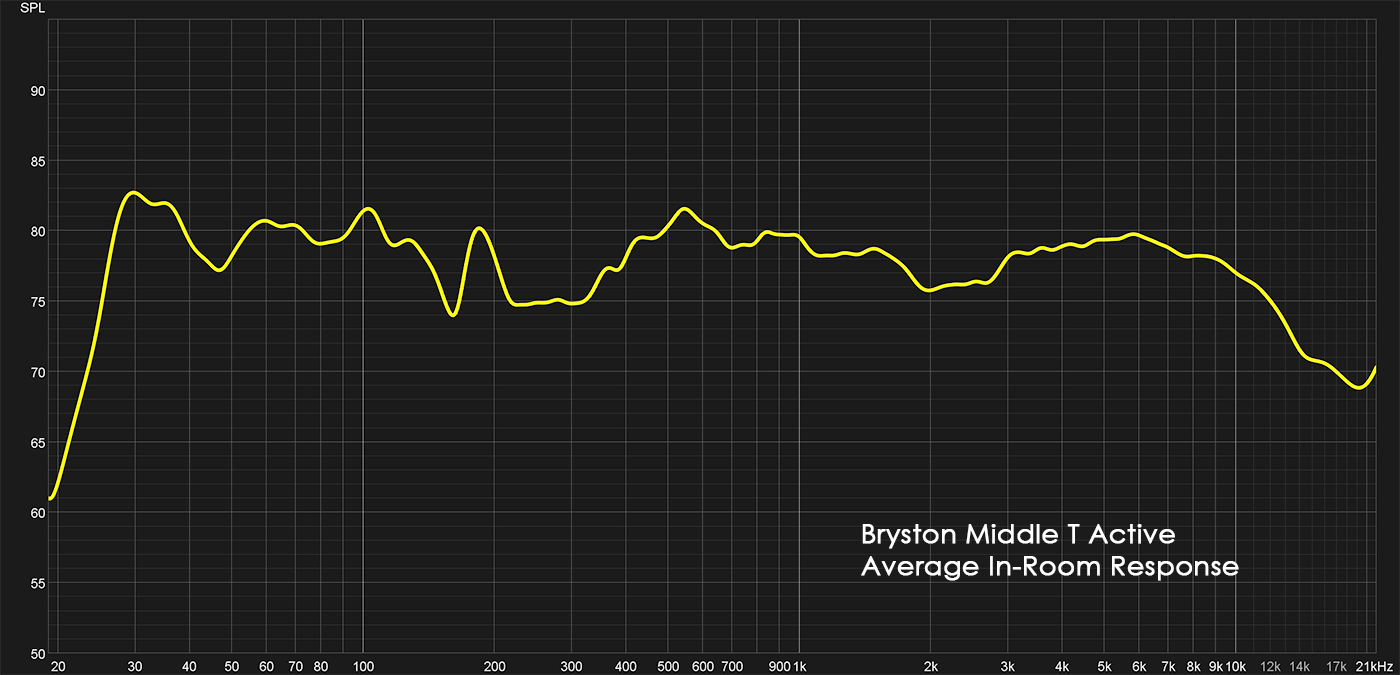
This in-room measurement is an 18-point spatial average. A 9-point measurement was made for the right speaker and then repeated for the left speaker. Averaging both speakers is an approach that others have been using and publishing. Using data from both speakers reduces the modal response of the room by averaging the differences in the response of the two speakers from room asymmetries. The technique cannot eliminate them however and, as such, the response below 300Hz remains room dominated. The results show a fairly consistent response from 400 Hz on up, exhibiting a couple of dips between 200 Hz – 400 Hz and between 2 – 3 kHz. The dip at 160 Hz seems to be an artifact of the room as it is showing up regularly in my measurements. Bass response is solid down to about 28 Hz before rolling off. Treble response seems to roll off beyond 10 kHz at a steeper rate than expected. The dip in the 2kHz – 3kHz range is strange since the goal of this DSP design was to improve the monotonic response of the listening window and the power response. The in-room response is a mix of those and the early reflections at the wall, floors, and ceiling. We capture those in the radiation pattern measurements below. The lift in the response of the tweeter is explained below.
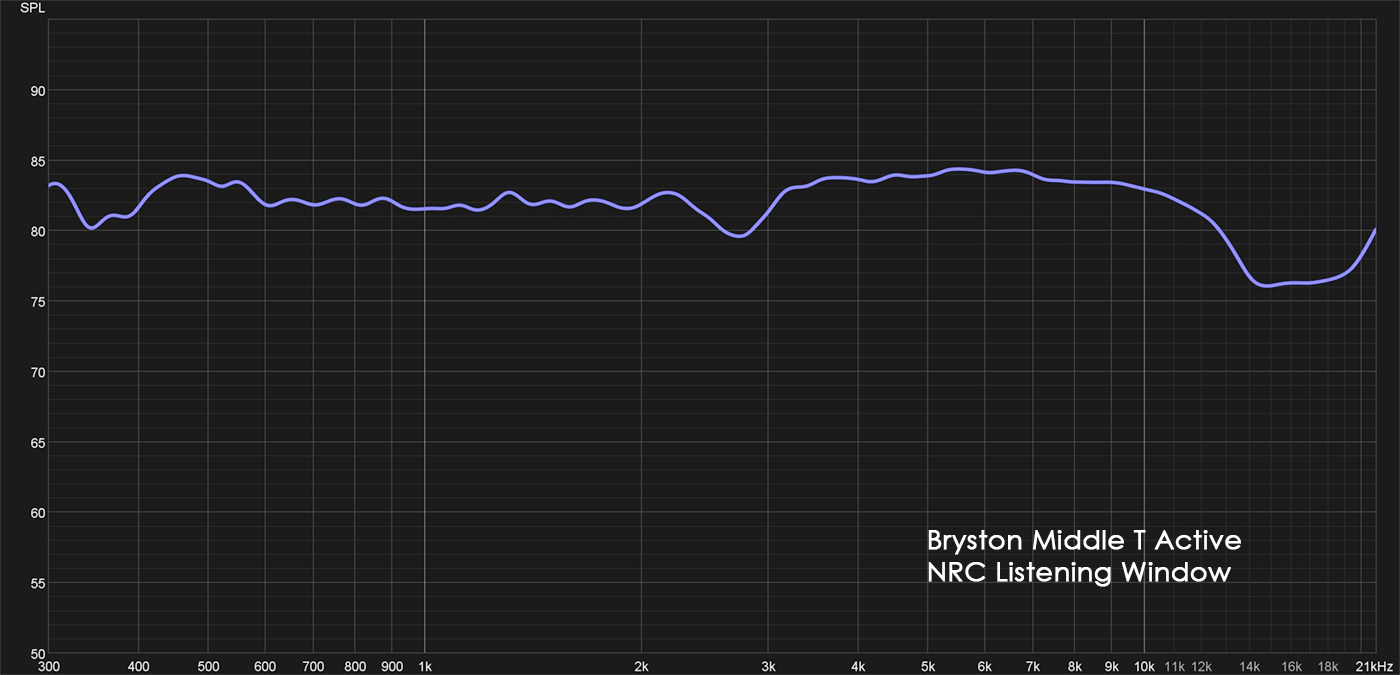
This is a plot of the NRC listening window scaled from 300 Hz on up which is averaged from the following measurements: 0-degree on-axis, +-15 vertical, +-15 horizontal, and +-30 horizontal. Here we see a nicely controlled and uniform response in the frequency range that is dominated by the speaker (response below 300 Hz tends to be dominated by the room and can vary greatly). One dip in the treble appears at around 2.7 kHz and the general tweeter level is above the midrange. This is strange and should be easily corrected with the DSP unit. Perhaps some setting was not correct when delivered. Unfortunately, we bench tested after the listening sessions and the speaker had to go back before we could change any settings.
The 2.7kHz dip is again unexpected given the stated goal of the DSP and is not in the data supplied by Bryston shown below.
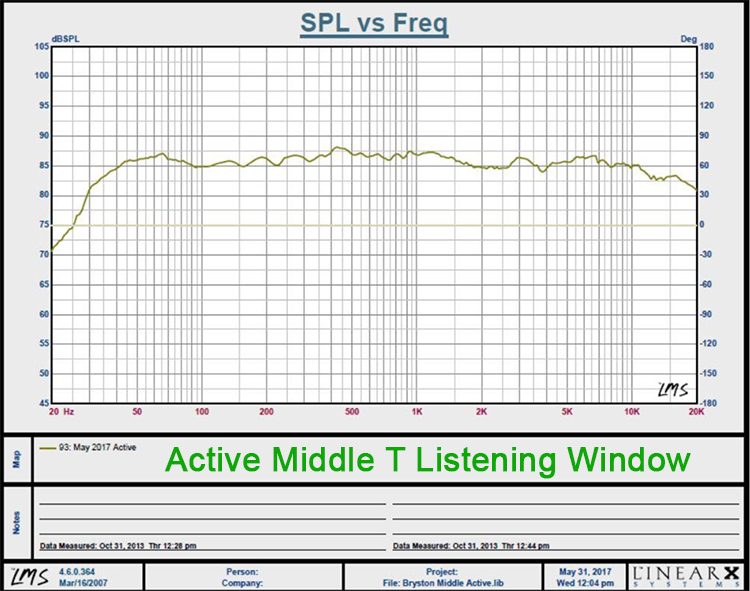
It should be noted that Bryston has an issue with how we take this data. In room we are restricted to place the microphone 3 feet back. If we increased the distance, the room reflections would corrupt the measurements. As Bryston points out, 3 feet is not far enough back to allow the sound from the drivers of this tall a speaker to adequately converge. As a result, any measurement below the frequency where the woofer is operational is not valid. The midrange and tweeter however are close enough to converge at 3 feet. We thus believe the data is valid above 1 kHz. I am also assuming that the BAX-1 had the latest DSP code installed for the speaker. Whether or not that was the same DSP code used when Bryston took their anechoic measurements, I cannot say. Regardless, as you can tell from my subjective observation, I really liked this speaker.
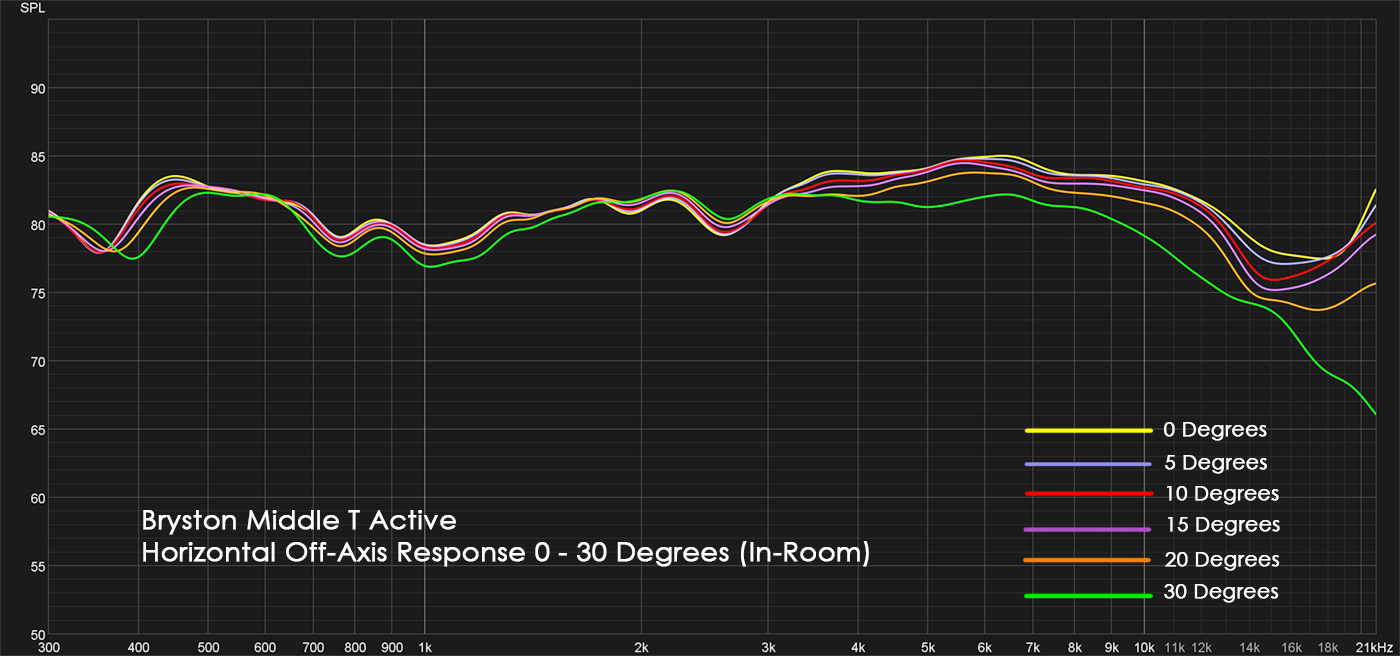
Above are the horizontal radiation curves of the Bryston Middle T Actives from 0 to 30 degrees. Looking at the angles most closely related to the direct response we see smooth curves with no obvious resonances at the 1/6 octave smoothing used here. The dip and the return at 18kHz are surprising for a speaker in this price range. This shows up in the passive version of the speaker in the graph we presented at the beginning of this review but was removed by the DSP in the active speaker. Again, this is a sign the DSP code in the unit we tested may not have been what was used to make the curves Bryston provided. The dip at 2.7 kHz does not change. The level error in the tweeter can be seen.

Above are the horizontal radiation curves from 45 to 90 degrees, scaled from 300 Hz on up. We see some non-monotonic behavior but only between 1.5kHz and 2kHz, an indication the design of the waveguide has been given significant attention by Bryston engineering. The active DSP complex filter is also responsible for this result. Again, we see the 2.7 kHz dip and the energy increase above 18kHz. No other resonances or diffraction issues are seen in these curves.
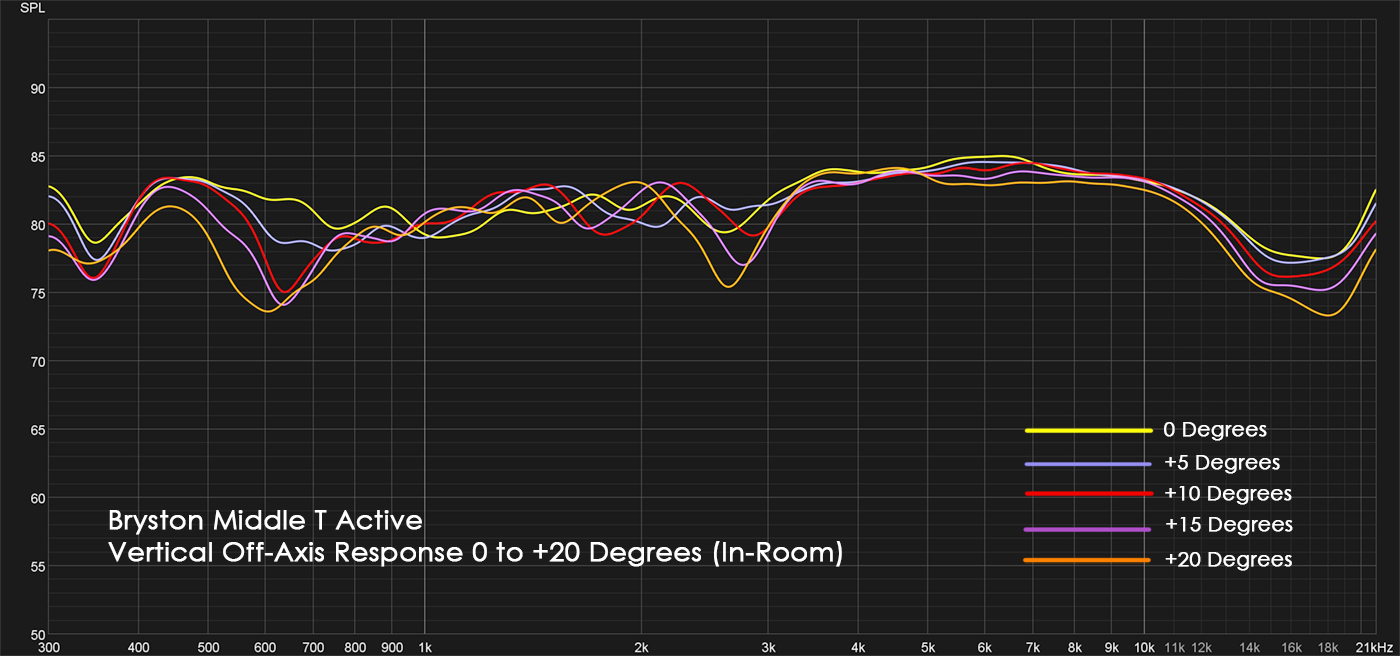
Moving to the vertical radiation pattern for positive angles, we see the plots for 0 to +20 degrees, scaled from 300 Hz on up. These show very little change outside the 2.7 kHz dip. We expect this in speakers with offset drivers, but it is unclear why the dip is already present on-axis. Note passive speakers would show much more variation around the crossover.
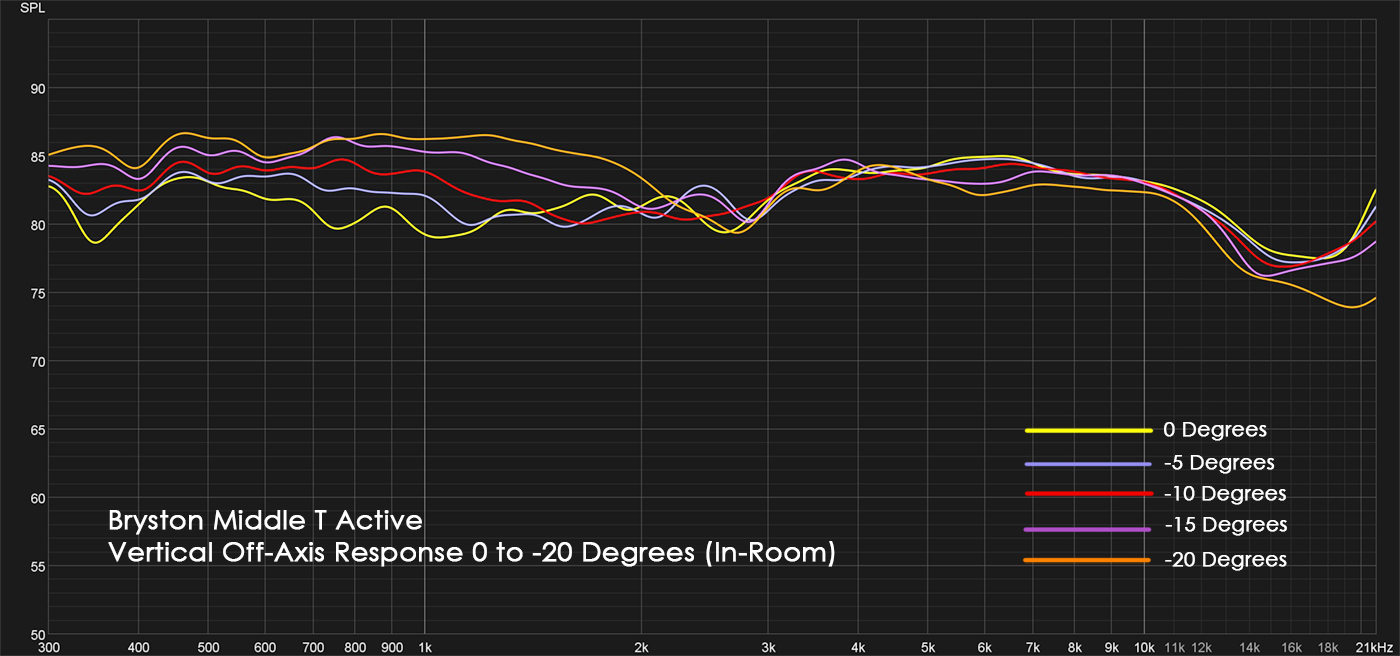
In the vertical radiation pattern for negative angles, we see the plots for 0 to -20 degrees, scaled from 300 Hz on up. Again, the crossover area between the woofer and tweeter shows little change. What is happening in the area of the midrange is a result of the microphone being at 3 feet not 6 feet. The speaker has not converged. That part of the measurement is wrong.
Overall a well-designed speaker that is significantly enhanced by using active DSP.
The only real issue is the tweeter level which is easily fixed with a code change and would only enhance the subjective performance of the speaker. The absence of the 2.7 kHz dip in the Bryston anechoic response indicates more DSP crossover tweaking in-room would have further enhanced performance.
Given the price and complexity of this system, a Bryston dealer will most likely set it up. During set up, they should do measurements to optimize the DSP to the room. I am not talking about room correction but the use of the DSP to allow the predicted in-room response from the anechoic chamber to more closely match what is measured in the room above 300Hz which is the lower crossover point.
As Bryston points out, changes in the crossover areas can be optimized to the driver since each driver is individually controlled by the DSP. A degree of freedom not possible with traditional room correction.

If you are looking for a 2-channel speaker system to rival the best out there, the BRYSTON MIDDLE T ACTIVE SPEAKERS demand serious consideration. They are outstanding!
- Wide dispersion design with excellent on- and off-axis imaging.
- Big soundstage with plenty of detail.
- Impressive bass response.
- Bryston build quality and warranty.
- Bryston 21B³ power amplifiers are glorious and ridiculously powerful.
- A little more adventurous look to the speakers themselves.
- Meld a Bryston preamp and a BAX-1 together and add direct digital inputs.
- A way for Middle T Passive owners to reasonably upgrade their speakers to Active.
So, I went from my last review of the little self-contained ELAC Navis bookshelf speakers to a whole other animal entirely in the Bryston Middle T Active loudspeakers. Two completely different ends of the spectrum but both interesting and effective applications of active speaker technology. With the Bryston loudspeakers, we have a not inexpensive ($36,570.00 as tested) system that can reproduce a very pleasing and full range level of sound with scale and dynamics that ranks among the best that I have come across. With some time and effort, one can use the parametric EQ tools aboard the crossover to correct any frequency anomalies below 150 Hz. And for anyone concerned about the crossover digitizing the incoming analog input for filtering adversely impacting the sound quality, forgot about it. Bring a bat or a dolphin to your local Bryston dealer to confirm your theory with an audition please because I certainly couldn’t hear anything that sounded off or hindered in transparency. That being said, it might be wise for Bryston in the future to consolidate the preamp and crossover features in one box. This would allow the addition of direct digital inputs for increased flexibility. While I may have wished that the Middle T Actives would have looked a little more interesting in their design, there is no denying that they are built to the same, almost heirloom, standard as all Bryston products. The 20-year warranty on the speakers and amps and 5 years for the crossover add piece of mind for a buyer contemplating such a significant purchase.
Now let me re-iterate, one doesn’t have to use Bryston amplifiers exclusively to power the Middle T Actives. One could substitute a fine multichannel amplifier(s) from other companies such as ATI, Emotiva, Parasound, Monoprice Monolith, etc. to substantially reduce the price of entry on these speakers and still achieve particularly good results. As an owner, should the time come that you are ready for a power amp upgrade, Bryston will surely be happy to provide some suggestions.
Active speakers are not a new concept, but they are a concept whose time may finally have come around for a wider acceptance among audiophiles. If you want to sample what active speakers are truly capable of, then I highly recommend you audition the Middle T Actives at a Bryston dealer. Not just if you are interested in purchasing but also to sample what is possible with a well thought out and executed active speaker design. You may very well get hooked!
The author wishes to thank David A. Rich for his assistance in this review.


